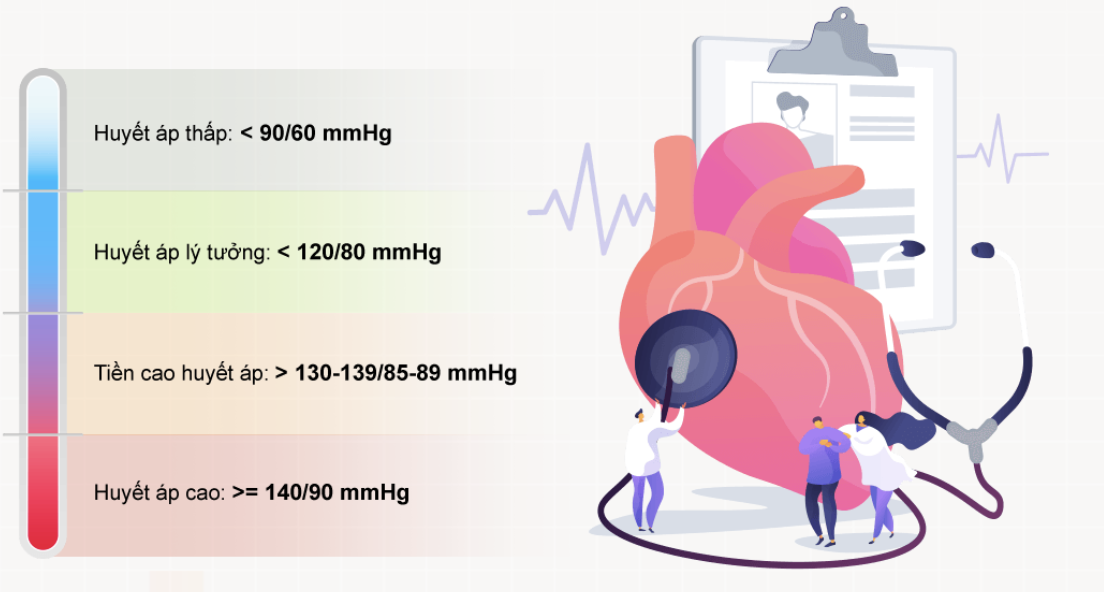What is blood pressure?
Blood pressure readings consist of two numbers, for example, 120/80 mmHg. These numbers represent:
Systolic blood pressure (the higher number): The pressure when the heart beats and pumps blood.
Diastolic blood pressure (the lower number): The pressure when the heart rests between beats.
How to measure blood pressure
Ensure the device is working correctly.
Empty your bladder before measuring.
Avoid smoking, drinking alcohol, or exercising 30 minutes before measuring.
Sit correctly.
Don't measure immediately after waking up.
See details: 5 tips for accurate blood pressure measurement
What are normal blood pressure readings?
Children
| Systolic blood pressure (mmHg) | Diastolic blood pressure (mmHg) | |
| Under 1 month old | 60-90 | 20-60 |
| 1 month to under 1 year old | 87-105 | 53-66 |
| 1 to under 3 years old | 95-105 | 53-66 |
| 3 to under 6 years old | 95-110 | 56-70 |
| 6 to under 13 years old | 97-112 | 57-71 |
| 13 to under 19 years old | 112-128 | 66-80 |
Adults
| Systolic blood pressure (mmHg) | Diastolic blood pressure (mmHg) | |
| 19 to 59 years old | < 140 | < 90 |
| 60 to 69 years old | < 140 | < 90 |
| 70 to 79 years old | < 140 | < 90 |
| 80 years and older | < 150 | < 90 |
Blood pressure tends to rise with age. While 90/60 mmHg might be low for adults, it's safe for young children.
 |
Blood pressure readings indicate health status. Design by Ngan Ha. |
Blood pressure-related conditions
Hypertension: High blood pressure against artery walls can lead to serious complications like stroke, heart attack, kidney failure, and heart failure.
Stroke: Occurs when a blood vessel in the brain bursts or is blocked, causing brain damage that can be fatal or result in severe disabilities.
Heart attack: A blockage of blood flow to the heart, leading to heart muscle damage and potentially death.
Kidney failure: Hypertension damages blood vessels in the kidneys, impairing kidney function.
Heart failure: The heart overworks to pump blood, leading to weakened heart muscle and an inability to supply enough blood to the body.
Peripheral artery disease: Hypertension can damage blood vessels in other parts of the body, like the legs and arms.
Angina: Chest pain or tightness due to reduced blood flow to the heart.
Preeclampsia and eclampsia: Dangerous conditions related to high blood pressure in pregnant women.
Managing blood pressure
Hypertension
Follow a healthy diet, such as the DASH (Dietary Approaches to Stop Hypertension) diet, which emphasizes fruits, vegetables, and whole grains.
Reducing salt (sodium) intake is crucial for lowering blood pressure.
Maintain a healthy weight.
Quit smoking.
Limit alcohol consumption.
Avoid stress.
See details: Managing high blood pressure
Low blood pressure
Stand up slowly.
Exercise regularly.
Eat several small meals.
Drink plenty of water.
Choose moderately salty foods.
See details: 5 tips for managing low blood pressure
Bao Bao












